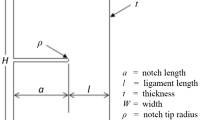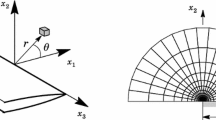Abstract
This study examines crack front length and constraint loss effects on cleavage fracture toughness in ferritic steels at temperatures in the ductile-to-brittle transition region. A local approach for fracture at the micro-scale of the material based on the Weibull stress is coupled with very detailed three-dimensional models of deep-notch bend specimens. A new non-dimensional function g(M) derived from the Weibull stress density describes the overall constraint level in a specimen. This function remains identical for all geometrically similar specimens regardless of their absolute sizes, and thus provides a computationally simple approach to construct (three-dimensional) fracture driving force curves σw vs. J, for each absolute size of interest. Proposed modifications of the conventional, two-parameter Weibull stress expression for cumulative failure probability introduce a new threshold parameter σw−min. This parameter has a simple calibration procedure requiring no additional experimental data. The use of a toughness scaling model including σw−min>0 increases the deformation level at which the CVN size specimen loses constraint compared to a 1T SE(B) specimen, which improves the agreement of computational predictions and experimental estimations. Finally the effects of specimen size and constraint loss on the cleavage fracture reference temperature T 0 as determined using the new standard ASTM E1921 are investigated using Monte Carlo simulation together with the new toughness scaling model.
Similar content being viewed by others
References
American Society for Testing and Materials, Philadelphia (1998). Test Method for the Determination of Reference Temperature T0 for Ferritic Steels in the Transition Range(ASTM E 1921).
Anderson, T.L. and Dodds, R.H. (1991). Specimen size requirements for fracture toughness testing in the ductilebrittle transition region. Journal of Testing and Evaluation 19, 123–134.
Anderson, T.L., Stienstra, D. and Dodds, R.H. (1994). A theoretical framework for addressing fracture in the ductile-to-brittle transition region. Fracture Mechanics: 24th Volume, ASTM STP 1207(Edited by J.D. Landes, D.E. McCabe and J. A. Boulet), American Society for Testing and Materials, Philadelphia, 186–214.
Bakker, A. and Koers, R.W.J. (1991). Prediction of cleavage fracture events in the brittle-ductile transition region of a ferritic steel. Defect Assessment in Components–Fundamentals and Applications, ESIS/EG9 (Edited by Blauel and Schwalbe), Mechanical Engineering Publications, London, 613–632.
Bass, B.R., McAfee, W.J. and Williams, P.T (1998). Evaluation of constraint methodologies applied to a shallow-flaw cruciform bend specimen tested under biaxial loading conditions. Proceedings, ASME/JSME Pressure Vessels and Piping Conference, San Diego, CA, July 26–30.
Beremin, F.M. (1983). A local criterion for cleavage fracture of a nuclear pressure vessel steel. Metallurgical Transactions 14A, 2277–2287.
Dodds, R.H., Anderson, T. L. and Kirk, M. T. (1991). A framework to correlate a/Wratio effects on elastic-plastic fracture toughness (J c). International Journal of Fracture 48, 1–22.
Gao, X., Faleskog, J. and Shih, C.F. (1999). Analysis of ductile to cleavage transition in part-through cracks using a cell model incorporating statistics. Fatigue & Fracture of Engineering Materials & Structures 22, 239–250.
Gao, X., Ruggieri and Dodds, R.H. (1998). Calibration ofWeibull stress parameters using fracture toughness data. International Journal of Fracture 92, 175–200.
Hahn, G.T. (1984). The influence of microstructure on brittle fracture toughness. Metallurgical Transactions A 15A, 947–959.
Hughes, T.J. (1980). Generalization of selective integration procedures to anisotropic and nonlinear media. International Journal for Numerical Methods in Engineering 15, 1413–1418.
Koppenhoefer, K., Gullerud, A., Ruggieri, C., Dodds, R. and Healy, B. (1998). 'WARP3D: Dynamic nonlinear analysis of solids using a preconditioned conjugate gradient software architecture', Structural Research Series (SRS) 596, UILU-ENG-94-2017, University of Illinois at Urbana–Champaign.
Koppenhoefer, K., and Dodds, R.H. (1997). A three-dimensional numerical investigation of loading rate effects on cleavage fracture of pre-cracked CVN specimens. Engineering Fracture Mechanics 58, 249–270.
Larsson, S.G. and Carlsson, A.J. (1973). Influence of non-singular stress terms and specimen geometry on small scale yielding at crack-tips in elastic-plastic materials. Journal of Mechanics and Physics of Solids 21, 447–473.
Lin, T., Evans, A.G. and Ritchie, R.O. (1986). A statistical model of brittle fracture by transgranular cleavage. Journal of Mechanics and Physics of Solids 21, 263–277.
McMahon, C.L. and Cohen, M. (1965). Initiation of cleavage in polycrystalline iron. Acta Metallurgica 13, 591–604.
Minami, F., Brückner-Foit, A., Munz, D. and Trolldenier, B. (1992). Estimation procedure for the Weibull parameters used in the local approach. International Journal of Fracture 54, 197–210.
Moinereau, D. (1996). Local approach to fracture applied to reactor pressure vessel: synthesis of a cooperative programme between EF, CEA, Framatome and AEA. Journal de Physique IV 6, 243–257.
Moran, B., and Shih, C.F. (1987). A general treatment of crack tip contour integrals. International Journal of Fracture 35, 295–310.
Mudry, F. (1987). A local approach to cleavage fracture. Nuclear Engineering and Design 105, 65–76.
Mudry, F., Rienzo, F.D. and Pineau, A. (1989). Numerical Comparison of Global and Local Fracture Criteria in Compact Tension and Center-Crack Panel Specimens. Non-linear Fracture Mechanics: II–Elastic-Plastic Fracture, ASTMSTP 995 (Edited by Landes et al.), American Society for Testing and Materials, Philadelphia, 24–39.
Nevalainen, M., and Dodds, R.H. (1995). Numerical investigation of three-dimensional constraint effects on brittle fracture in SE(B) and C(T) specimens. International Journal of Fracture 74, 131–161.
Press, W.H., Teukolsky, S.A., Vetterling, W.T. and Flannery, B.P. (1992). Numerical Recipes in FORTRAN: The Art of Scientific Computing, 2nd ed., Cambridge University Press.
Rice, J.R. (1974). Limitations to the small scale yielding approximation for crack tip plasticity. Journal of Mechanics and Physics of Solids 22, 17–26.
Ruggieri, C., Minami, F. and Toyoda, M. (1995). A statistical approach for fracture of brittle materials based on the chain-of-bundles model. Journal of Applied Mechanics 62, 320–328.
Ruggieri, C. and Dodds, R.H. (1996). A transferability model for brittle fracture including constraint and ductile tearing effects: a probabilistic approach. International Journal of Fracture 79, 309–340.
Ruggieri, C., and Dodds, R.H. (1998). Numerical evaluation of probabilistic fracture parameters with WSTRESS. Engineering Computations 15, 49–73.
Ruggieri, C., Dodds, R.H. and Wallin, K. (1998). Constraint effects on reference temperature T0 for ferritic steels in the transition region. Engineering Fracture Mechanics 60, 19–36.
Sorem, W.A., Dodds, R.H. and Rolfe, S.T. (1991). Effects of crack depth on elastic-plastic fracture toughness. International Journal of Fracture 47, 105–126.
Wallin, K. (1984). The scatter in KIc results. Engineering Fracture Mechanics 19, 1085–1093.
Wallin, K., Saario, T., and Torronen, K. (1984). Statistical model for carbide induced brittle fracture in steel. Metal Science 18, 13–16.
Wallin, K. (1991). Fracture toughness transition curve shape for ferritic structural steels. Fracture of Engineering Materials and Structures(Edited by S.T. Teoh and K.H. Lee), Elsevier Applied Science, 83–88.
Wallin, K. (1993). Statistical aspects of constraint with emphasis on testing and analysis of laboratory specimens in the transition region. Constraint Effects in Fracture, ASTM STP 1171 (Edited by Hackett, et al.), American Society for Testing and Materials, Philadelphia, 264–288.
Wang, Y.Y. (1991). A two-parameter characterization of elastic-plastic crack-tip and applications to cleavage fracture. PhD thesis, Department of Mechanical Engineering, MIT.
Wiesner, C.S. and Goldthorpe, M.R. (1996). The effect of temperature and specimen geometry on the parameters of the local approach to cleavage fracture. Journal de Physique IV 6, 295–304.
Williams, M.L. (1957). On the stress distribution at the base of a stationary crack. Journal of Applied Mechanics 24, 109–114.
Xia, L. and Shih, C.F. (1996). Ductile crack growth–III. transition to cleavage fracture incorporating statistics. Journal of Mechanics and Physics of Solids 44, 603–639.
Xia, L. and Cheng, L. (1997). Transition from ductile tearing to cleavage fracture: A cell model approach. International Journal of Fracture 87, 289–305.
Author information
Authors and Affiliations
Rights and permissions
About this article
Cite this article
Gao, X., Dodds, R. Constraint effects on the ductile-to-brittle transition temperature of ferritic steels: a Weibull stress model. International Journal of Fracture 102, 43–69 (2000). https://doi.org/10.1023/A:1007526006632
Issue Date:
DOI: https://doi.org/10.1023/A:1007526006632




